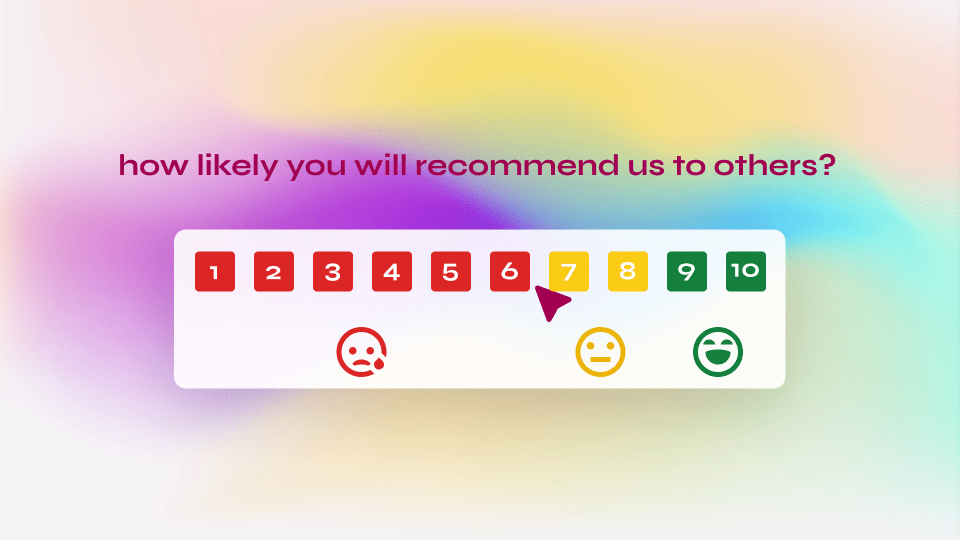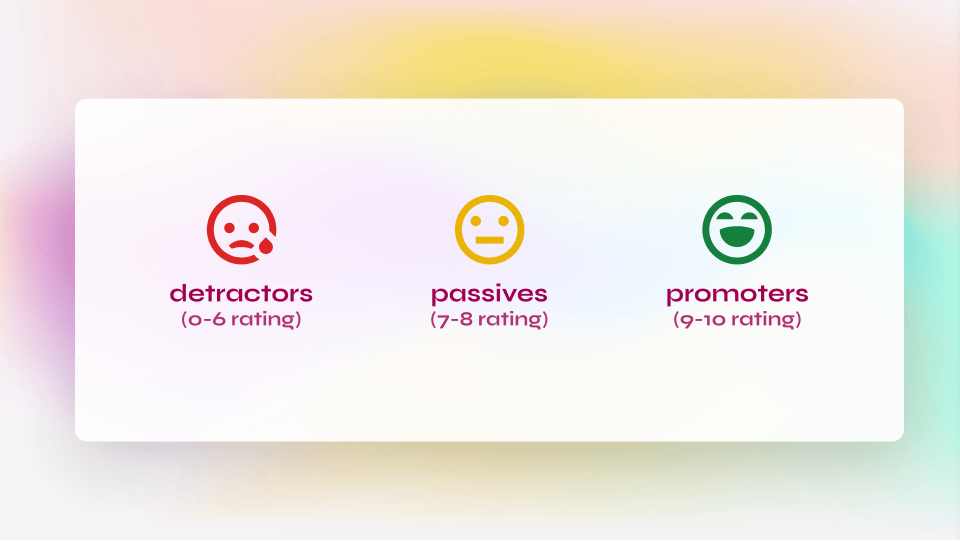As a business owner, have you ever wondered how satisfied your customers are with your services? For that, you can track your sales numbers and monitor your customer churn rate. But how do you know if your customers are truly happy with what you provide them?
That's where the Net Promoter Score (NPS) comes in.
Let's say you own a SaaS company that offers project management software. You have a large customer base, and you want to know how likely they are to recommend your product to their colleagues and friends.
Calculating your NPS can provide valuable insights into how satisfied your customers are with your services. It can also help you gauge their likelihood of referring your business to others.
But what exactly is NPS, and how do you calculate it?
In this blog post, we'll dive into the specifics of NPS, how it can benefit your SaaS company, and step-by-step instructions on calculating it.
So, let's get started!
What Is Net Promoter Score (NPS)?
NPS stands for Net Promoter Score; a metric companies use to measure customer loyalty and satisfaction. You can calculate NPS by asking your customers to rate, on a scale of 0 to 10, how likely they are to recommend a company or product to a friend or colleague.
Bain & Company, the creator of the NPS methodology, conducted a survey and found that companies with the highest NPS scores tend to grow two times faster than their competitors with lower scores. It highlights the importance of customer satisfaction and loyalty in driving business growth and success.
NPS Formula
The Net Promoter Score (NPS) is calculated based on a simple formula that involves asking customers a single question:
"On a scale of 0 to 10, how likely are you to recommend our product/service to a friend or colleague?"

Based on the responses received, customers are categorized into three groups:
- Promoters (score of 9 or 10): These customers are highly satisfied with the product/service and will likely recommend it to others.
- Passives (score of 7 or 8): These customers are satisfied with the product/service but may not be as enthusiastic as promoters. They are less likely to recommend the product/service to others.
- Detractors (score of 0 to 6): These customers are unhappy with the product/service and are unlikely to recommend it to others.

To obtain the Net Promoter Score (NPS), you need to take the percentage of promoters and subtract the percentage of detractors. The result is a score that ranges from -100 (if all customers are detractors) to 100 (if all customers are promoters).
NPS = % of Promoters - % of Detractors
Importance Of NPS
Net Promoter Score is important for businesses in many ways, but here are some of those highlighted for you:
1. Helps Measure Customer Loyalty
The Net Promoter Score (NPS) is a commonly employed measure for evaluating customer loyalty and contentment. In fact, according to Qualtrics' study in 2022, 72% of companies today use NPS to measure customer experience. By measuring customer loyalty, businesses can identify areas where they excel and areas that need improvement.
2. Predicts Business Growth And Revenue
As mentioned earlier, companies with the highest NPS scores tend to grow two times faster than their competitors with lower scores. It highlights the importance of NPS in predicting business growth and revenue. When loyal customers are satisfied, they are more likely to continue doing business with the company and recommend it to others.
3. Identifies Areas For Improvement
NPS surveys provide valuable customer feedback that can help businesses identify areas for improvement. For example, a company with many detractors may indicate issues with its products or services that must be addressed.
Analyzing feedback received through NPS surveys enables businesses to pinpoint specific pain points in the customer experience.
By identifying these areas, businesses can take targeted action to improve them and enhance customer satisfaction and loyalty. This process helps businesses remain competitive by continuously improving the quality of their services or products.
4. Helps Track Progress Over Time
NPS surveys help in tracking progress over time. By measuring NPS scores regularly, businesses can monitor customer satisfaction and loyalty changes and track progress toward their goals. It helps businesses stay focused on their customer experience strategy and make data-driven decisions to improve customer satisfaction and loyalty.
For example, if a company sees a decline in its NPS score over time, it may need to investigate the reasons for the decline and take appropriate action to improve.
5. Provides Benchmark For Comparison With Competitors
You can use NPS to compare your company's performance with competitors. By measuring NPS scores for multiple companies in the same industry, businesses can gain insights into how they stack up against their competitors. It helps businesses identify areas where they need to catch up and take action to improve.
For example, if a company has a lower NPS score than its competitors, it may need to invest in improving the customer experience to remain competitive.
6. Aids In Making Data-Driven Decisions
NPS provides quantitative data that you can use in making data-driven decisions. Businesses can gain insights into customer preferences, pain points, and overall satisfaction levels by analyzing NPS scores and feedback.
Businesses make informed decisions about their customer experience strategy, such as:
- Which areas to focus on for improvement
- Which products or services to prioritize
- How to allocate resources
Steps To Calculate NPS (Using the formula)
Here are the steps to calculate NPS using the formula:
Step 1: Identify Survey Respondents
Select a sample of customers who have interacted with your product/service in the recent past. You can send them an email or text message survey or provide a link to a web survey.
Step 2: Ask NPS Question
Send out a survey to your customers asking them the customer satisfaction survey questions, such as - "On a scale of 0 to 10, how likely are you to recommend our product/service to a friend or colleague?"
Step 3: Calculate Percentage Of Promoters
Promoters are customers who score your product/service between 9-10. To calculate the percentage of promoters, add up the number of responses with a rating of 9 and 10, and divide by the total number of responses. For example, if 100 customers responded, and 60 gave a score of 9 or 10, the percentage of promoters would be 60%.
Step 4: Calculate Percentage Of Detractors
Detractors are customers who score your product/service between 0-6. To calculate the percentage of detractors, add the number of responses with a rating from 0-6, and divide by the total number of responses. For example, if 100 customers responded, and 20 gave a score of 0-6, the percentage of detractors would be 20%.
Step 5: Subtract Percentage Of Detractors From Percentage Of Promoters
The final step is subtracting the percentage of detractors from the percentage of promoters. For example, if the percentage of promoters is 60% and the percentage of detractors is 20%, the NPS score would be 40 (60% - 20%).
Step 6: Interpret the NPS score
The NPS score can range from -100 to 100. A score of 0 indicates equal numbers of promoters and detractors.
A positive score (up to 100) indicates that you have more promoters than detractors. On the other hand, a negative score (down to -100) indicates that you have more detractors than promoters.
Generally, a score above 50 is considered excellent, while a score below 0 is considered poor. A high NPS score is generally considered a good indicator of customer loyalty and satisfaction. A low score indicates areas where improvements need to be made.
Tips For Obtaining Accurate NPS Scores
Here are some of the best tips for you to obtain accurate NPS scores:
1. Use An Appropriate Scale
Using an appropriate scale for your particular industry or product/service is important. The standard 0-10 scale is widely used, but some industries may use different scales.
2. Ensure The NPS Question Is Unambiguous
The NPS question should be easy to understand and not open to interpretation. It should also focus specifically on the likelihood of recommending the product/service to others.
3. Determine An Appropriate Sample Size
The sample size should be large enough to be statistically significant but not so large that it becomes unmanageable. The appropriate sample size will depend on the size of the target population and the level of accuracy required.
4. Ensure The Survey Represents The Target Population
It's important to ensure that the survey is representative of the target population, including factors such as age, gender, location, and other demographic variables. It will help to ensure that the results are accurate and meaningful.
5. Timing Of The Survey
The timing of the survey can also impact the accuracy of the NPS score. It's important to choose when customers are likely to think about their experience with the product/service, such as immediately after making a purchase or receiving a service.
Wrapping Up
Calculating an NPS score is an effective way to measure customer loyalty and satisfaction. Businesses can gain valuable insights into how customers perceive their product or service by asking a simple question and using a straightforward formula.
Olvy is a valuable customer feedback platform that can assist businesses in collecting feedback swiftly and obtaining a net promoter score. It offers the necessary tools for constructing a feedback loop and enhancing the NPS.
Olvy automates gathering, analyzing, and reporting customer feedback data, allowing companies to take immediate and constructive measures to improve their services or product offerings.
Overall, Olvy's services can assist businesses in establishing an effective feedback system that can lead to higher customer satisfaction and increased growth.


